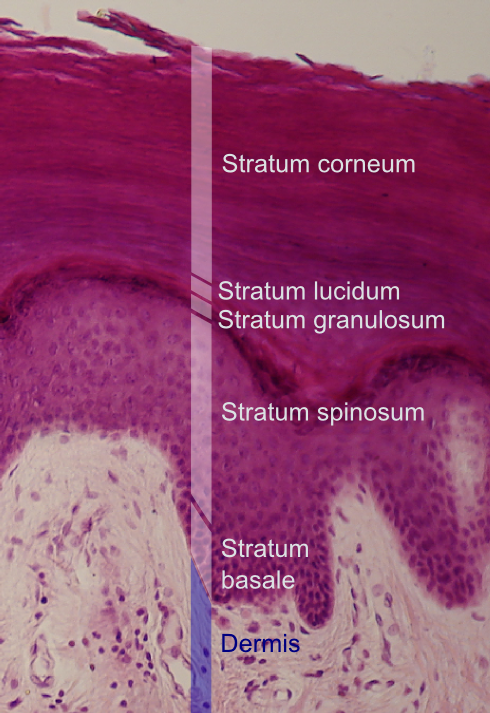spinous layer on:
[Wikipedia]
[Google]
[Amazon]
 The stratum spinosum (or spinous layer/prickle cell layer) is a layer of the
The stratum spinosum (or spinous layer/prickle cell layer) is a layer of the
Image:Normal Epidermis and Dermis with Intradermal Nevus 10x.JPG, Epidermis and dermis of human skin
Image:Skinlayers.png, Section of epidermis
 The stratum spinosum (or spinous layer/prickle cell layer) is a layer of the
The stratum spinosum (or spinous layer/prickle cell layer) is a layer of the epidermis
The epidermis is the outermost of the three layers that comprise the skin, the inner layers being the dermis and Subcutaneous tissue, hypodermis. The epidermal layer provides a barrier to infection from environmental pathogens and regulates the ...
found between the stratum granulosum
The stratum granulosum (or granular layer) is a thin layer of cells in the epidermis lying above the stratum spinosum and below the stratum corneum ( stratum lucidum on the soles and palms).James, William; Berger, Timothy; Elston, Dirk (2005) ''A ...
and stratum basale
The stratum basale (basal layer, sometimes referred to as ''stratum germinativum'') is the deepest layer of the five layers of the epidermis, the external covering of skin in mammals.
The stratum basale is a single layer of columnar or cuboida ...
. This layer is composed of polyhedral keratinocyte
Keratinocytes are the primary type of cell found in the epidermis, the outermost layer of the skin. In humans, they constitute 90% of epidermal skin cells. Basal cells in the basal layer (''stratum basale'') of the skin are sometimes referre ...
s. These are joined with desmosome
A desmosome (; "binding body"), also known as a macula adherens (plural: maculae adherentes) (Latin for ''adhering spot''), is a cell structure specialized for cell-to-cell adhesion. A type of junctional complex, they are localized spot-like ad ...
s. Their spiny (Latin, spinosum) appearance is due to shrinking of the microfilament
Microfilaments, also called actin filaments, are protein filaments in the cytoplasm of eukaryotic cells that form part of the cytoskeleton. They are primarily composed of polymers of actin, but are modified by and interact with numerous other ...
s between desmosomes that occurs when stained with H&E. Keratinization
Keratin () is one of a family of structural fibrous proteins also known as ''scleroproteins''. It is the key structural material making up scales, hair, nails, feathers, horns, claws, hooves, and the outer layer of skin in vertebrates. Kera ...
begins in the stratum spinosum, although the actual keratinocytes begin in the stratum basale
The stratum basale (basal layer, sometimes referred to as ''stratum germinativum'') is the deepest layer of the five layers of the epidermis, the external covering of skin in mammals.
The stratum basale is a single layer of columnar or cuboida ...
. They have large pale-staining nuclei as they are active in synthesizing fibrillar proteins, known as cytokeratin
Cytokeratins are keratin proteins found in the intracytoplasmic cytoskeleton of epithelial tissue. They are an important component of intermediate filaments, which help cells resist mechanical stress. Expression of these cytokeratins within ep ...
, which build up within the cells aggregating together forming tonofibrils
Tonofibrils are cytoplasmic protein structures in epithelial tissues that converge at desmosomes and hemidesmosomes. They consist of fine fibrils in epithelial cells that are anchored to the cytoskeleton. They were discovered by Rudolf Heidenhai ...
. The tonofibrils go on to form the desmosomes, which allow for strong connections to form between adjacent keratinocytes. The stratum spinosum also contains Langerhans cell
A Langerhans cell (LC) is a tissue-resident macrophage of the skin once thought to be a resident dendritic cell. These cells contain organelles called Birbeck granules. They are present in all layers of the epidermis and are most prominent in t ...
s, which functions as a macrophage by engulfing bacteria, foreign particles, and damaged cells that occur in this layer.
Clinical significance
Diffusehyperplasia
Hyperplasia (from ancient Greek ὑπέρ ''huper'' 'over' + πλάσις ''plasis'' 'formation'), or hypergenesis, is an enlargement of an organ or tissue caused by an increase in the amount of Tissue (biology), organic tissue that results from ...
of the stratum spinosum is termed acanthosis
The epidermis is the outermost of the three layers that comprise the skin, the inner layers being the dermis and hypodermis. The epidermal layer provides a barrier to infection from environmental pathogens and regulates the amount of water relea ...
.
Additional images
See also
Spinous cellReferences
{{integumentary system Skin anatomy Epithelial cells